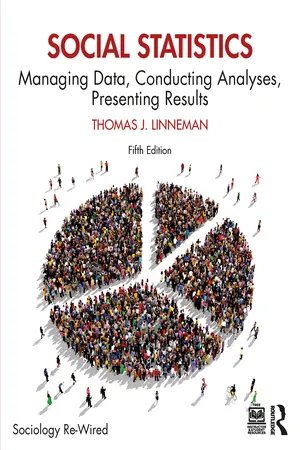
Social Statistics
Managing Data, Conducting Analyses, Presenting Results
- English
- ePUB (mobile friendly)
- Available on iOS & Android
About this book
With a clear, engaging writing style and fascinating examples using a variety of real data, this text covers the contemporary statistical techniques that students will encounter in the world of social research. It covers these techniques at an introductory level and carefully guides students through increasingly complex examples without intimidating them. Recurrent examples using four timely topics—immigration, income inequality, the distribution of household labor, and health (including attitudes toward doctors and pandemic restrictions)—help students understand how the techniques fit together and how to use the techniques in combination with one another. A superb author-created web resource accompanies the text. How to make clear presentations of research results is also a feature of the text.
New to this edition:
- Most of the literature examples that end each chapter are new and use very recent research from top academic journals (over half of the new literature examples are from 2023 or 2024). They feature research about some of the most pertinent and provocative social issues of the day: political polarization, conspiracy beliefs, mental health, transgender support, racial stereotypes, vaccine refusal, sexual harassment, and numerous facets of the COVID-19 pandemic.
- Examples throughout the book use the most recent data from the General Social Survey. Four timely topics are threaded throughout the book: immigration, income inequality, the distribution of household labor, and health. Linneman uses these topics recurrently with different statistical techniques to illustrate how the techniques are related to one another.
- The new edition more explicitly emphasizes that the various techniques the students are learning are often used in combination with one another. Linneman carefully scaffolds the techniques, introducing a new technique and then showing how this technique can be combined with techniques taught in previous chapters. He does this with a new emphasis on psychologically supporting students who might be trepidatious about their newfound statistical skills.
Frequently asked questions
- Essential is ideal for learners and professionals who enjoy exploring a wide range of subjects. Access the Essential Library with 800,000+ trusted titles and best-sellers across business, personal growth, and the humanities. Includes unlimited reading time and Standard Read Aloud voice.
- Complete: Perfect for advanced learners and researchers needing full, unrestricted access. Unlock 1.4M+ books across hundreds of subjects, including academic and specialized titles. The Complete Plan also includes advanced features like Premium Read Aloud and Research Assistant.
Please note we cannot support devices running on iOS 13 and Android 7 or earlier. Learn more about using the app.
Information
Table of contents
- Cover
- Half Title
- Series
- Title
- Copyright
- Contents
- Detailed Contents
- Preface to the Fifth Edition
- Acknowledgments
- Chapter 1: Life in a Data-Laden Age: Finding and Managing Datasets
- Chapter 2: The Art of Visual Storytelling: Creating Accurate Tables and Graphs
- Chapter 3: Summarizing Center and Diversity: Basic Descriptive Statistics
- Chapter 4: Using Sample Crosstabs to Talk About Populations: The Chi-Square Test
- Chapter 5: Using a Sample Mean or Proportion to Talk About a Population: Confidence Intervals
- Chapter 6: Using Multiple Sample Means to Talk About Populations: t-Tests and ANOVA
- Chapter 7: Give Me One Good Reason Why: Bivariate Correlation and Regression
- Chapter 8: Using Sample Slopes to Talk About Populations: Inference and Regression
- Chapter 9: It’s All Relative: Dichotomies as Independent Variables in Regression
- Chapter 10: Above and Beyond: The Logic of Controlling and the Power of Nested Regression Models
- Chapter 11: Some Slopes Are Bigger Than Others: Calculating and Interpreting Beta Coefficients
- Chapter 12: Different Slopes for Different Folks: Interaction Effects
- Chapter 13: Explaining Dichotomous Outcomes: Logistic Regression
- Chapter 14: Visualizing Causal Stories: Path Analysis
- Chapter 15: Questioning the Greatness of Straightness: Nonlinear Relationships
- Chapter 16: Problems and Prospects: Regression Diagnostics, Advanced Techniques, and Where to Go Now
- Appendix A: Variables and Indexes from the Datasets Used in the End-of-Chapter Exercises
- Appendix B: 125 Articles That Use Statistics in Less than Scary Ways
- Appendix C: Statistical Tables
- Appendix D: Answers to Odd-Numbered End-of-Chapter Exercises
- Bibliography
- Index